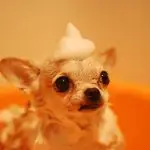Solving the tear staining in small dog breeds
There are several dog breeds that have an inherent issue with tear staining. The most obvious ones are the white or light color dogs such as the Bichon breeds. Although they by no means are the only ones, the bichon breeds, being long-haired, non shedding breeds, tend to need daily eye-care to avoid tear staining. Tear staining is the reddish-brown discoloration that may be found at the inner corners of the eyes and under the eyes.
Staining around the eye is caused by tearing excessive issues. This excessive tearing is a medical limitation called “epiphora.”
There are a variety of potential factors that can cause epiphora and the resulting staining. These include heredity, infection, negligence in grooming, improper diet, allergies, drinking water factors, fleas, and teething,
We’ll check out each of these possible causes of excessive tearing and staining. As well, we’ll consider some of the actions that we, as owners of an at-risk dog, can take to successfully address these issues.
HEREDITY
Studies indicate that 20% – 25% of small dogs are born with closed, shallow, or narrow tear ducts. One function of properly formed tear ducts is to connect the eye vicinity with the naso-pharyngeal area and provide a drainage between these areas. When the tear ducts are closed, shallow, or narrow, the tear ducts overflow because there is an inadequate (or closed) channel for the passage of fluids.
If the tear ducts are clogged or narrow, there is a veterinary procedure which may help mitigate the complication. When this is a viable option, a veterinarian may flush the tear duct while the dog is under light anesthesia. Successfully performed, this procedure not only flushes out the tear duct, but helps to open and occasionally slightly stretches the duct. If a congenitally narrow tear duct can be slightly stretched as a by-product of this procedure, it can allow extra adequate drainage to occur.
If the excessive tearing is due to hereditary or congenital factors, daily care will be a primary factor in alleviating the associated problems. (Proper daily care will be addressed in the GROOMING section of this work).
INFECTION
When the facial hair stays damp from excessive tearing, it is the breeding ground for bacteria and yeast. In this situation “Ptyrosporin” or “Red Yeast” is one of the most conventional yeast infections that can result. It causes a deep reddish-brown stain. Similarly, a low-grade bacterial infection can, in turn, cause excessive tearing. A viscous cycle of excessive tearing and infection can ensue. What begins as a tiny staining problem can develop into the signs of a extra alarming underlying health issue.
When infection is suspected, it is urgent that a veterinarian be consulted, as prescription antibiotics will be needed. These may be in the form of oral medication or drops. It is of little value to work on discoloration without identifying and treating the cause of the problem In combination with medication, the eye area must be cleaned. A daily routine will be needed to keep the eye area healthy and looking good.
GROOMING
An effective grooming routine for the enclosure around the eyes is a critical part of the solution to excessive tearing and the resulting stain issues.
Competent grooming should begin with recondition hands. Any matter that has accumulated in the corners of the eyes should then be removed. It may help to use a cotton moistened with warm water to loosen the matter. A commercial cleaning product for hair around the eyes, as long as it is designated as safe for daily use, is another way to purify off the accumulated matter.
Hair near the corners of the eyes naturally gets moist from tears and then fosters the growth of bacteria and yeast. Therefore, trimming the hair in this zone (and keeping it trimmed) is a big step in eliminating the breeding ground for matter accumulation, infection, and staining. Similarly, some breeds have a classic hair style that, unchecked, may allow hair above the eyes to raise far enough down so that it hangs in the eyes and causes irritation. This, in turn, causes excessive tearing. Trimming this hair so that it cannot touch the eyes is also urgent for stopping irritation that triggers excessive tearing.
ALLERGIES
Nourishment allergies, plant allergies, and allergies to shampoos and other household chemicals (such as air or carpet fresheners) can cause excessive tearing.
DRINKING WATER
High mineral levels in the drinking water can cause excessive tearing. Bottled or filtered water can be a healthier alternative for all dogs for abundance reasons, including excessive tearing issues.
FOOD
Numerous commercial dog foods (and treats!) contain preservatives, additives, foodstuff dyes that can cause staining. It is in the best curiosity of your dog that you read the labels carefully, not just on their main foods, but also on their treats.
FLEAS
Fleas need wetness to live. The eye surface produces an ideal place for them. Flea feces can contribute to the red stains around the eyes.
Hopefully this data has provided some very effective ways to address the causes of excessive tearing so that the associated staining and health challenges do not have to be chronic issues for your 4-legged buddy.


